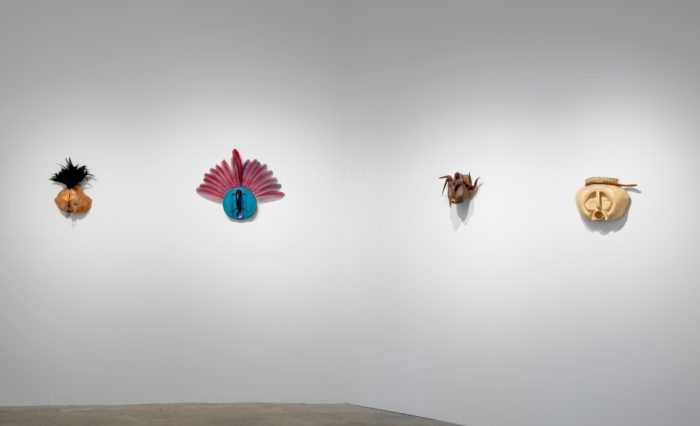
Romuald Hazoumè’s masks are objects of recovery and recognition. For the last thirty years, the Benin-based artist has fashioned remarkable disguises from found objects and the detritus of illicit trade. The tops of from oil bidons become faces — some narrow and long, others round — with handles for noses and open-spout mouths. Feathers become hair, as do tobacco pipes and old scrubbing brushes. Taken together, the masks express a full range of emotion: they are pained, imploring, bemused and nonplussed.
By any measure, these works, a small group of which is currently on view at Gagosian’s Park and 75, are objectively delightful. Hazoumè harnesses tremendous power in simple configurations, beautifully curated colors and clever use of otherwise unremarkable items. At first glance, the pieces clearly mark an original contribution to West Africa’s rich tradition of mask-making, and draw parallels to the work of contemporary Western artists, most notably John Chamberlain whose own masks were showcased by Gagosian last year.
There’s much more going on here than just this, though. The masks may be beautiful, but their materials gesture to the ugly legacies of colonialism and modern capitalism that define and distort Benin’s political economy. Since transitioning to democracy in the early 1990s, the country has struggled against growing poverty, abysmal literacy rates, dependency on subsistence agriculture and the hegemony of neighboring Nigeria. In particular, Benin has become reliant on Nigerian fuel, much of which is illicitly trafficked and then sold on the black market.
According to the African Development Bank, the trade in bootleg oil produces nearly 80 percent of all fuel consumed in Benin. It also provides jobs. Estimates suggest some 200,000 young men and women help move an average of 150,000 barrels of contraband petrol across the border each day. Traffickers purchase state-subsidized gasoline in Nigeria, smuggle it into Benin and then sell it informally to locals at cut-rate prices, offering a cheap alternative to official rates. The work can be profitable, but it’s also unstable and frequently dangerous.
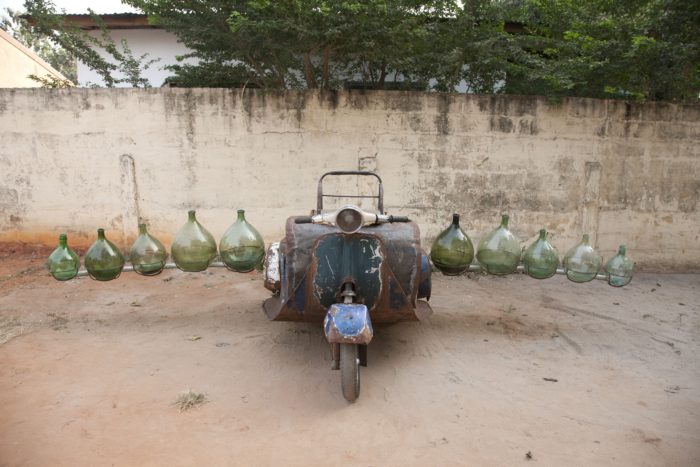
Hazoumè has addressed these concerns most forcefully with his camera. In a series of documentary photographs — not included in this exhibit, unfortunately — Hazoumè
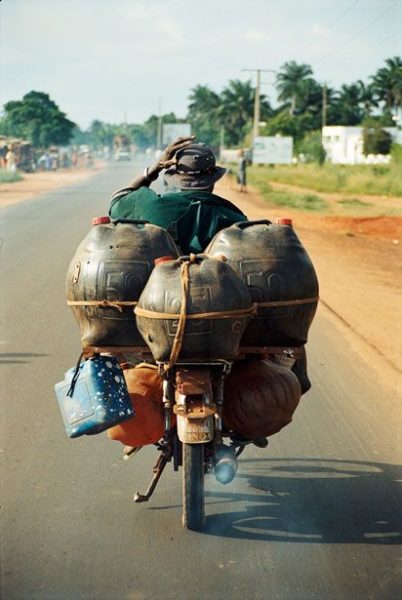
We may catch a pair of arms sticking out to guide the scooter in these shots or the back of a head; rarely a face. The point Hazoumè makes is clear enough: the product, and getting it to market, is paramount. Whether the traffickers spend hours inhaling noxious fumes during each trip is of no account. Death, encountered by hundreds of smugglers each year in fiery road accidents, is merely incidental. Individuals, Hazoumè seems to suggest, are both the engines of this economic activity and entirely expendable, easily forgotten.
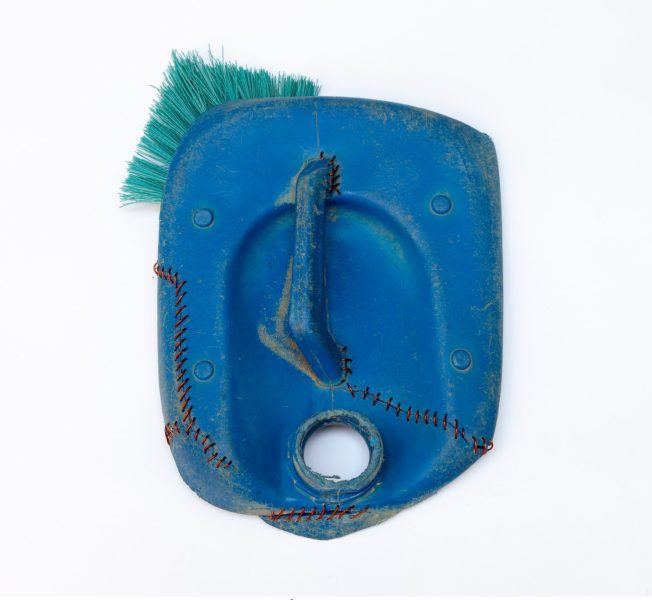
In this sense, the masks represent the identities of countless workers erased by the exigencies of the market. They’re a colorful lot. Hazoumè’s signal achievement lies in fashioning distinct personalities — and even histories — for each face, rendering assemblages of used items into something distinctly human. One mask, for example, presents us with the scarred face of a torn blue container which has been stitched back together for further use. A tuft of green brush hair shoots off one side, leaving the impression of a battered, tough but not unfriendly man.
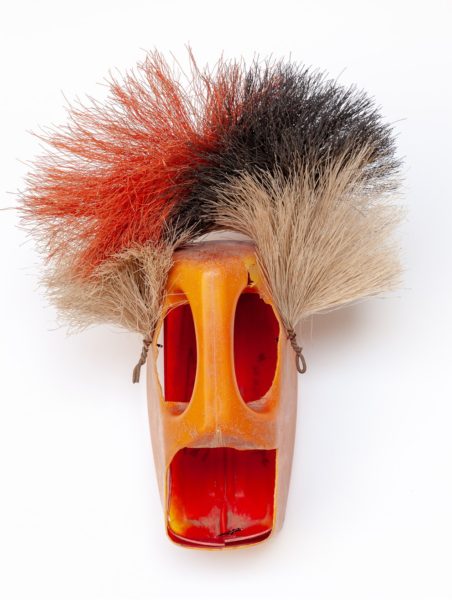
Another mask, this one with wide eyes and a gaping mouth, emerges from a bright yellow and orange container. Pinned to both sides of the face, an array of orange, black, and yellow broom-bristles suggests someone in a constant state of agitation who nevertheless keeps it stylish. A third, made from a weathered brown container with orange highlights, features a compact, slightly squeezed face adorned with locks of discarded smoking pipes, and indicates acute intelligence and no-nonsense demeanor.
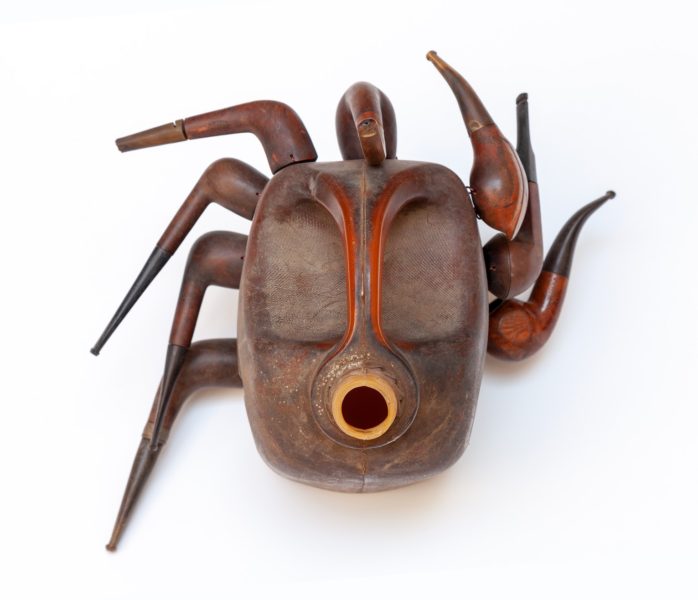
There’s a solemnity to these acts of symbolic recognition, but dark humor as well. Like the wondrous, Afrofuturist landscapes of Bodys Isek Kingelez, currently given their due at the Museum of Modern Art, Hazoumè’s masks comprise the waste of industrial globalization. The similarities end there, however. Kingelez, whose genius remained mostly unrecognized beyond the borders of Congo during his lifetime, repurposed garbage into spectacular art largely for his own satisfaction.
By contrast, Hazoumè pursues an overtly political agenda in his work, theoretically and materially, about which he is explicit. “I send back to the West that which belongs there,” he noted a few years back. “That is to say, the refuse of a consumer society that invades [Benin] every day.” Consider it a kind of radical recycling. Hazoumè converts the flotsam of global commodity chains into blue chip work fetching top dollar in New York, London, and Paris — a delicious act of minor revenge.
“Romuald Hazoumè” continues at Gagosian Park & 75 (821 Park Avenue, Upper East Side, Manhattan) through October 13.

Brilliant, Mike. Thanks for bringing this art to my attention. I need to see more work of Africans. A powerful antidote to my complacency.
Tim
Thanks for Commenting!